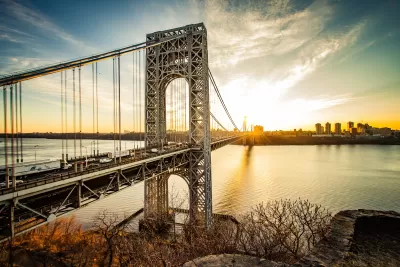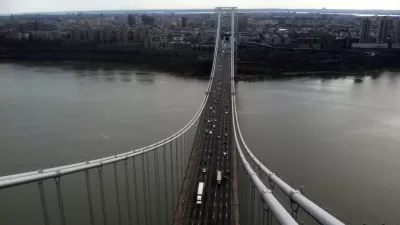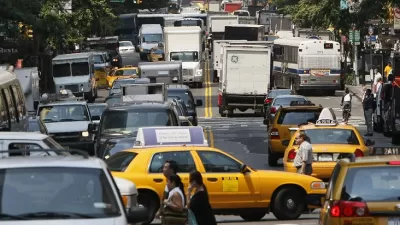The State of New Jersey filed a federal lawsuit against the U.S. Department of Transportation on Friday to halt the Manhattan cordon pricing project approved in June by the FHWA, charging that they violated the National Environmental Protection Act.

“On Friday, the state filed a lawsuit against the U.S. Department of Transportation (USDOT) and the Federal Highway Administration (FHWA) to block what it describes as ‘the ill-conceived congestion pricing plan,’” reported Matthew Fazelpoor for NJBIZ, the state's leading business journal. More details have emerged since Planetizen first covered the story.
When the FHWA cleared the controversial pricing project last month, “New Jersey leaders noted they had retained Randy Mastro and Craig Carpenito of law firm King & Spalding and were exploring all legal options,” added Fazelpoor. “And on Friday, the state did indeed take legal action.”
The suit argues that the USDOT and the FHWA violated the National Environmental Protection Act, which requires a full environmental impact review for efforts of this projected impact and scope, as well as the Clean Air Act.
Tolls, not environment, prompts lawsuit
“We believe the feds short-circuited the normal review process,” Democratic Gov. Phil Murphy said in an interview on Good Day New York, reported Jimmy Vielkind for The Wall Street Journal on July 21.
Murphy argued that the new tolls will unfairly target New Jersey drivers, who already pay a $17 toll to use the Lincoln or Holland tunnels into Manhattan. Around 111,000 people drove into Manhattan’s business district from New Jersey on an average fall weekday in 2019, according to the New York Metropolitan Transportation Council, a planning group.
“We can’t fix a broken MTA [Metropolitan Transportation Authority] in New York City on the back of New Jersey commuters,” states Murphy on pg. 2 of the 68-page lawsuit [pdf]. “It’s a huge tax on them, and frankly, it challenges our environment because of all the re-routing of traffic that will take place.”
The current plan allows for a peak-hour toll as high as $23 for drivers who enter the cordon below 60th Street in Manhattan. An alternative plan, posted here July 18, would set the maximum at $15.
“Lisa Daglian, who heads an advisory committee that advocates for MTA riders, said most New Jersey residents who commute to Manhattan come on trains or in buses and many of them then ride the subway,” added Vielkind.
“We strongly condemn this lawsuit for its attempt to halt progress on improving transit, reducing congestion and pollution, and creating a healthier and more sustainable region,” she said.
The road pricing program, scheduled to take effect next year, could mean billions of dollars in new transit funding for the MTA.
Additional coverage in Bloomberg City Lab: “New Jersey Sues Over Congestion Pricing Plan in New York City,” July 21, 2023
FULL STORY: New Jersey files federal lawsuit to block congestion pricing in NYC

Planetizen Federal Action Tracker
A weekly monitor of how Trump’s orders and actions are impacting planners and planning in America.

Trump Administration Could Effectively End Housing Voucher Program
Federal officials are eyeing major cuts to the Section 8 program that helps millions of low-income households pay rent.

The 120 Year Old Tiny Home Villages That Sheltered San Francisco’s Earthquake Refugees
More than a century ago, San Francisco mobilized to house thousands of residents displaced by the 1906 earthquake. Could their strategy offer a model for the present?

Philadelphia Councilmember Proposes Transit Access Fund
The plan would allocate 0.5 percent of the general fund toward mobility subsidies for low-income households.

Texas Bill Would Ban Road Diets, Congestion Pricing
A Texas state senator wants to prevent any discussion of congestion pricing and could suspend existing bike lane and sidewalk projects.

USDOT Threatens to Pull New York Highway Funding
The Trump administration wants the state to kill New York City’s congestion pricing program despite its demonstrated success.
Urban Design for Planners 1: Software Tools
This six-course series explores essential urban design concepts using open source software and equips planners with the tools they need to participate fully in the urban design process.
Planning for Universal Design
Learn the tools for implementing Universal Design in planning regulations.
Ada County Highway District
Clanton & Associates, Inc.
Jessamine County Fiscal Court
Institute for Housing and Urban Development Studies (IHS)
City of Grandview
Harvard GSD Executive Education
Toledo-Lucas County Plan Commissions
Salt Lake City
NYU Wagner Graduate School of Public Service





























